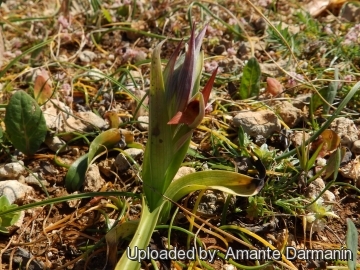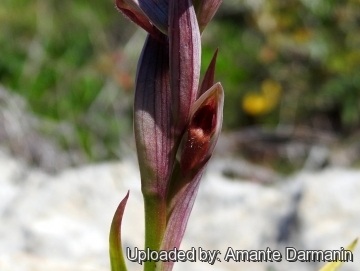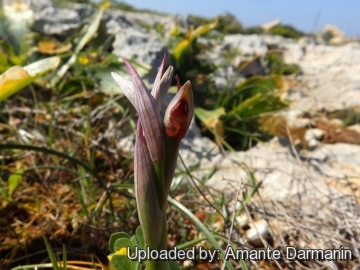Accepted Scientific Name: Serapias parviflora Parl.
Giorn. Sci. Sicilia 59: 66 (1837).

Serapiastrum parviflorum (Serapias parviflora) Photo by: Amante Darmanin
Small-flowered serapias, Orkida tal-ilsien zghira. Marfa ridge, Malta. 22-03-2017
Origin and Habitat: Serapias parvifloraSN|34120]]SN|34120]] is native to the Mediterranean Basin from the Iberian Peninsula through North Africa and the Mediterranean to the Aegean Sea, the Maltese islands, the western Anatolia and in Apulia, the only Italian region of presence, as well as in the Canary Islands and the Atlantic coast of coast of France. It was also found in Cornwall (United Kingdom), and may have dispersed there naturally.
Habitat and ecology: This species is frequent to common in garigue, rocky steppe, rocky valleys, but unlike many of its relatives is rarely found in large colonies.
Synonyms:
See all synonyms of Serapias parviflora
back
Accepted name in llifle Database:Serapias parviflora Parl.Giorn. Sci. Sicilia 59: 66 (1837).Synonymy: 18
back
Common Names include:
ENGLISH: Small Tongue Orchid, Lesser Tongue Orchid, Small Flowered Tongue Orchid
DUTCH (Nederlands): kleine tongorchis
FRENCH (Français): Sérapias à petites fleurs
ITALIAN (Italiano): Serapide minore
MALTESE (Malti): Orkida tal-Ilsien Zghira, Orkida tal-Ilsien Żgħira
RUSSIAN (Русский): Серапиас мелкоцветковый
SPANISH (Español): serapias de flor pequeña
Description: The lesser tongue-orchids, Serapias parviflora is a perennial orchid with slender and channelled leaves springing from two spherical, sessile tubers. It grows to around 10–30 cm high (at times up to 40 cm). The flowers are arranged in a spike. The greyish-pink sepals and petals form a hood over the column and the lip, which is typically 14–19 mm long. The prominent lip and the absence of a spur are distinctive characters of this species.
Derivation of specific name: Its name appropriately means small-flowered.
Leaves: Basal leaves four to seven, 6-10 cm long, 7-10 mm wide, elongate (linear-lanceolate) keeled and channelled, sheathing the stem, spreading to erect, glaucous- green, the basal sheaths green, often flecked with purple spots. The upper 1–3 leaves (further up the stem) are smaller bract-like.
Inflorescence: The flowers are small, borne in a lax 3-5-flowered, (rarely up to 12) elongated, racemose spike; bracts shorter than to as long as the upwardly angled outer perianth segments, brown to purple, partially obscuring the small flowers.
Flowers: The flowers are small (15-20 mm long). The greyish-pink sepals and petals are converging and form a hood over the column. The sepals are red-green to grey-lilac, 14-18 mm long, 3.5-4.5 mm wide.The pointed hood 14-19 mm long, mainly pale purplish (or pinkish brown) with faint green and veined, the "tongue" (median lobe of lip) brownish-red to purplish-red, pointing downwards, often curving backwards, with two red-purple calluses at the base. Side lobes of lip (labellum) 13-15 mm long, 3-4 mm wide, red-green mostly concealed within hood. Hypochile (the basal portion of the lip) 8-1 0 x 9-1 1.5 mm, with a wedge-shaped base, the lateral lobes brown-red. Epichile (the apical portion of the lip) lanceolate, 7-1.5 mm long 2.5-4.5 mm wide, directed downwards or backwards, slightly hairy, dull red. Flower colour is however variable and due to anthocyanin deficiency can often appear pale or yellowish. Flowers completely lacking this vascular pigmentation are rare. Column elongate, ending in pointed connective. Pollinia two, with distinct caudicles. Ovary erect, not twisted, sessile. Bracts pointed and veined, shorter or longer than hood and same colour or darker than the hood. Serapias paiviflora is regularly self-pollinating.
Blooming season: Spring ( March to June)
Chromosome number: 2n = 36.
Similar species: S. parviflora, is easily distinguished by its significantly smaller flowers, though on occasion small flowered forms of Serapias bergonii can create problems of identification.
Bibliography: Major references and further lectures
1) Alex Casha “Flora of the Maltese Islands” Volume 4 Lulu.com, 28 June 2014
2) Crinan Alexander “Orchids of the British Isles” Griffin Press, 01 January 2005
3) Bellusci F., and Aquaro G, “Contribution to the cytotaxonomical knowledge of four species of Serapias L. (Orchidaceae)”, in Caryologia 2008; 61(3) 294-299.
4) Delforge P., “Orchids of Europe, North Africa And the Middle East”, Timber Press, 2006
5) Pignatti S., “Flora d'Italia”, Bologna, Edagricole, 1982
6) Wikipedia contributors. "Serapias parviflora." Wikipedia, The Free Encyclopedia. Wikipedia, The Free Encyclopedia, 7 Nov. 2016. Web. 30 Mar. 2017.
7) Anne Harrap & Simon Harrap "Small-flowered tongue orchid, Serapias parviflora". Orchids of Britain and Ireland: a Field and Site Guide. A&C Black. (2009).
8) "Serapias parviflora". John and Gerry's Orchids of Britain and Europe. Retrieved 29-03-2017 from http://www.orchidsofbritainandeuropetest.uk/Serapias%20parviflora.html
 Serapias parviflora, Marfa ridge, Malta. 22-03-2017 (Serapias parviflora) Photo by: Amante Darmanin
Serapias parviflora, Marfa ridge, Malta. 22-03-2017 (Serapias parviflora) Photo by: Amante Darmanin Serapias parviflora, Marfa ridge, Malta. 22-03-2017 (Serapias parviflora) Photo by: Amante Darmanin
Serapias parviflora, Marfa ridge, Malta. 22-03-2017 (Serapias parviflora) Photo by: Amante Darmanin Serapias parviflora, Marfa ridge, Malta. 22-03-2017 (Serapias parviflora) Photo by: Amante Darmanin
Serapias parviflora, Marfa ridge, Malta. 22-03-2017 (Serapias parviflora) Photo by: Amante DarmaninSend a photo of this plant.The gallery now contains thousands of pictures, however it is possible to do even more. We are, of course, seeking photos of species not yet shown in the gallery but not only that, we are also looking for better pictures than those already present.
Read More...











